上海徐汇区小学三年级英语语法全
- 格式:doc
- 大小:239.43 KB
- 文档页数:12
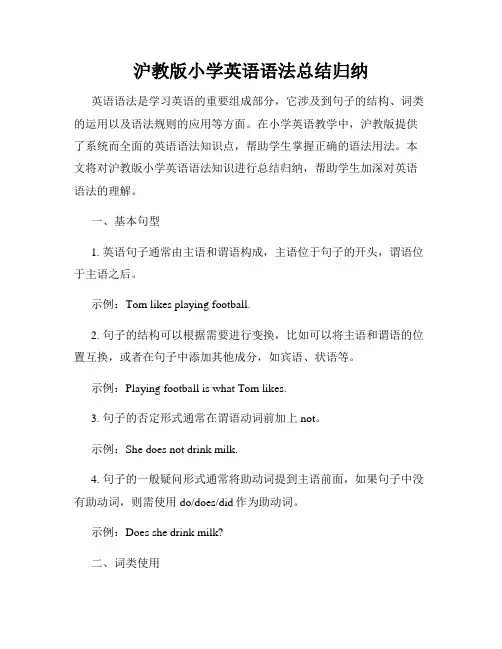
沪教版小学英语语法总结归纳英语语法是学习英语的重要组成部分,它涉及到句子的结构、词类的运用以及语法规则的应用等方面。
在小学英语教学中,沪教版提供了系统而全面的英语语法知识点,帮助学生掌握正确的语法用法。
本文将对沪教版小学英语语法知识进行总结归纳,帮助学生加深对英语语法的理解。
一、基本句型1. 英语句子通常由主语和谓语构成,主语位于句子的开头,谓语位于主语之后。
示例:Tom likes playing football.2. 句子的结构可以根据需要进行变换,比如可以将主语和谓语的位置互换,或者在句子中添加其他成分,如宾语、状语等。
示例:Playing football is what Tom likes.3. 句子的否定形式通常在谓语动词前加上not。
示例:She does not drink milk.4. 句子的一般疑问形式通常将助动词提到主语前面,如果句子中没有助动词,则需使用do/does/did作为助动词。
示例:Does she drink milk?二、词类使用1. 名词:作为句子中的主语或宾语,表示人、物、地方或抽象概念。
示例:He is a student.I have a dog.2. 代词:用来代替名词,以避免重复使用。
示例:He is my friend. → He is a nice boy.3. 形容词:用来修饰名词,描述人或物的特征。
示例:She is a beautiful girl.4. 动词:用来表示动作或状态。
示例:They are playing basketball.5. 副词:用来修饰动词、形容词或其他副词,表示时间、地点、程度等情况。
示例:He runs fast.6. 介词:用来表示方位、时间、方式等。
示例:She is at home.7. 连词:用来连接词语、短语或句子。
示例:I like apples and bananas.三、时态的应用1. 现在时态:用来表示现在正在进行或经常发生的动作。
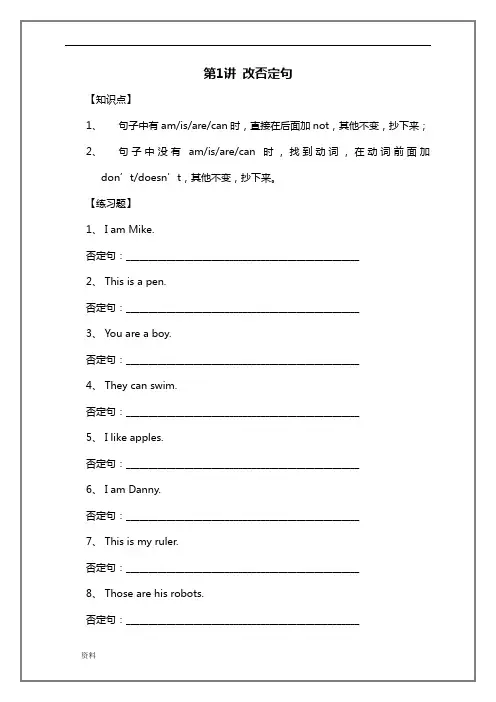
第1讲改否定句【知识点】1、句子中有am/is/are/can时,直接在后面加not,其他不变,抄下来;2、句子中没有am/is/are/can时,找到动词,在动词前面加don’t/doesn’t,其他不变,抄下来。
【练习题】1、I am Mike.否定句:____________________________________________________2、This is a pen.否定句:____________________________________________________3、You are a boy.否定句:____________________________________________________4、They can swim.否定句:____________________________________________________5、I like apples.否定句:____________________________________________________6、I am Danny.否定句:____________________________________________________7、This is my ruler.否定句:____________________________________________________8、Those are his robots.否定句:____________________________________________________9、You can go to have a look.否定句:____________________________________________________ 10、I know his name.否定句:____________________________________________________ 11、I am a student.否定句:____________________________________________________ 12、It is an apple.否定句:____________________________________________________ 13、They are my books.否定句:____________________________________________________ 14、I can see a boat.否定句:____________________________________________________ 15、Stand up.否定句:____________________________________________________ 16、I am in Grade 3.否定句:____________________________________________________ 17、She is Yang Ling.否定句:____________________________________________________ 18、We are teachers.否定句:____________________________________________________ 19、I can draw a toy car.否定句:____________________________________________________20、Jack speaks English very well.否定句:____________________________________________________第2讲改一般疑问句【知识点】1、句子中有am/is/are/can时,放句首,其他不变,抄下来。
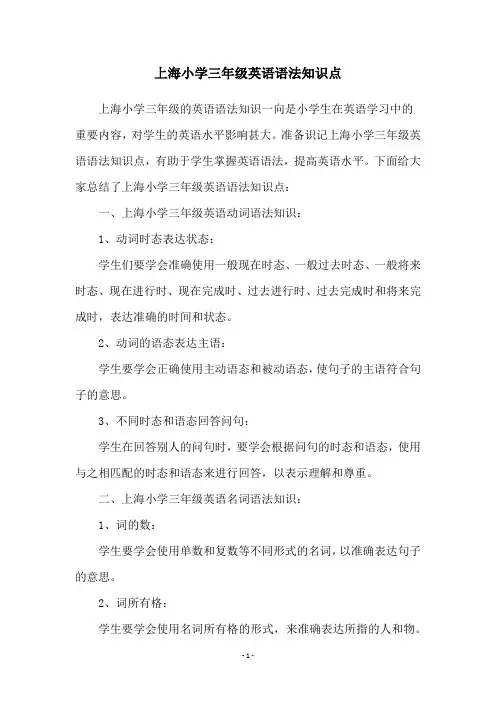
上海小学三年级英语语法知识点上海小学三年级的英语语法知识一向是小学生在英语学习中的重要内容,对学生的英语水平影响甚大。
准备识记上海小学三年级英语语法知识点,有助于学生掌握英语语法,提高英语水平。
下面给大家总结了上海小学三年级英语语法知识点:一、上海小学三年级英语动词语法知识:1、动词时态表达状态:学生们要学会准确使用一般现在时态、一般过去时态、一般将来时态、现在进行时、现在完成时、过去进行时、过去完成时和将来完成时,表达准确的时间和状态。
2、动词的语态表达主语:学生要学会正确使用主动语态和被动语态,使句子的主语符合句子的意思。
3、不同时态和语态回答问句:学生在回答别人的问句时,要学会根据问句的时态和语态,使用与之相匹配的时态和语态来进行回答,以表示理解和尊重。
二、上海小学三年级英语名词语法知识:1、词的数:学生要学会使用单数和复数等不同形式的名词,以准确表达句子的意思。
2、词所有格:学生要学会使用名词所有格的形式,来准确表达所指的人和物。
3、词的格:学生要学会使用主格、宾格和表格等,使句子结构正确,表达句子的意思准确。
三、上海小学三年级英语代词语法知识:1、容词性物主代词:学生要学会准确使用形容词性物主代词,以正确表达名词的指示。
2、人称代词:学生要学会准确使用人称代词,使句子表达准确。
3、示代词:学生要学会准确使用指示代词,以正确表达句子的意思和宾语的指示。
四、上海小学三年级英语冠词语法知识:1、词的使用:学生要学会准确使用冠词,恰当表达句子的意思。
2、不定冠词的使用:学生要学会使用不定冠词“a”、“an”的用法,对名词的数、性和发音做出准确的区分。
3、冠词的使用:学生要学会使用定冠词“the”在特定条件下的使用,以表达准确的意思。
以上就是上海小学三年级英语语法知识点的内容,希望这些内容能够帮助大家了解英语语法,掌握基本的语法,提高英语水平。
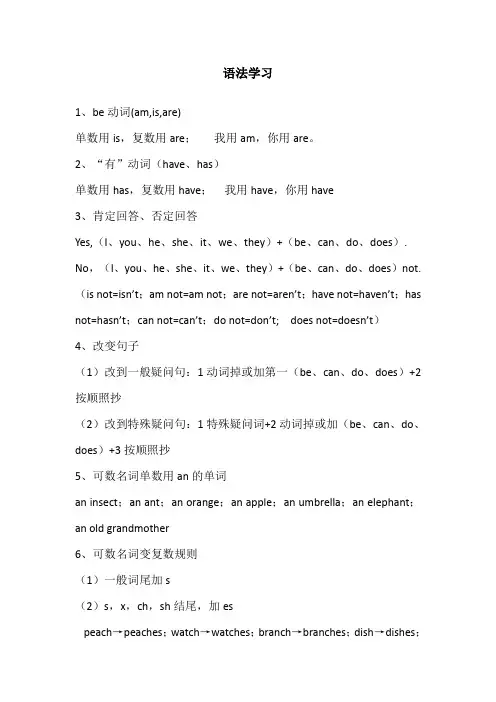
语法学习1、be动词(am,is,are)单数用is,复数用are;我用am,你用are。
2、“有”动词(have、has)单数用has,复数用have;我用have,你用have3、肯定回答、否定回答Yes,(I、you、he、she、it、we、they)+(be、can、do、does). No,(I、you、he、she、it、we、they)+(be、can、do、does)not. (is not=isn’t;am not=am not;are not=aren’t;have not=haven’t;has not=hasn’t;can not=can’t;do not=don’t; does not=doesn’t)4、改变句子(1)改到一般疑问句:1动词掉或加第一(be、can、do、does)+2按顺照抄(2)改到特殊疑问句:1特殊疑问词+2动词掉或加(be、can、do、does)+3按顺照抄5、可数名词单数用an的单词an insect;an ant;an orange;an apple;an umbrella;an elephant;an old grandmother6、可数名词变复数规则(1)一般词尾加s(2)s,x,ch,sh结尾,加espeach→peaches;watch→watches;branch→branches;dish→dishes;bus→buses;box→boxes;fox→foxes(3)辅音+y结尾,y变i再加es;元音+y结尾,加sbaby→babies;butterfly→butterflies;library→libraries;family→familiesboy→boys;monkey→monkeys;day→days(4)以f或fe结尾,一般变f或fe为v,再加es:wolf→wolves;leaf→leaves(5)字母变化变复数man→men;woman→women;tooth→teeth;mouse→mice;child→children(5)单复数同形:sheep→sheep;fish→fish(6)只有复数形式:trousers裤子;clothes衣服;shorts短裤9、动词后面+ing:双写+ing:run→running;swim→swimming;shop→shopping;cut→cutting;put→putting;去掉e+ing:write→writing;dance→dancing;make→making;have→having;love→loving10、there be 结构,意思为有,单数用there is ,复数用there are ,判断是单数还是复数,看there be 后面跟的第一个名称。
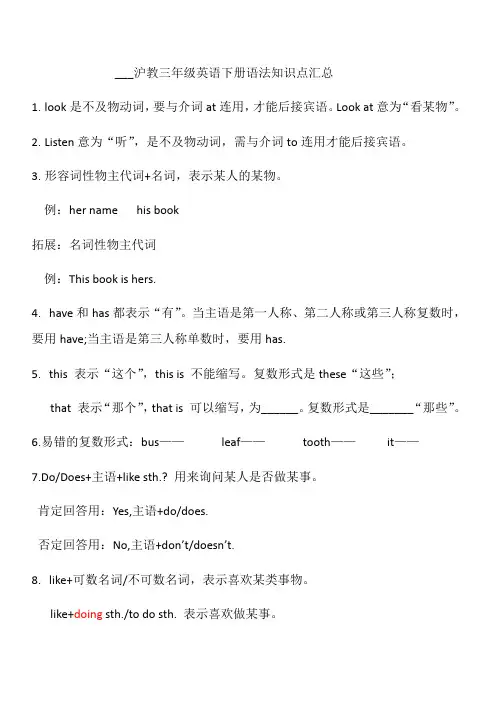
___沪教三年级英语下册语法知识点汇总1.look是不及物动词,要与介词at连用,才能后接宾语。
Look at意为“看某物”。
2.Listen意为“听”,是不及物动词,需与介词to连用才能后接宾语。
3.形容词性物主代词+名词,表示某人的某物。
例:her name his book拓展:名词性物主代词例:This book is hers.4.have和has都表示“有”。
当主语是第一人称、第二人称或第三人称复数时,要用have;当主语是第三人称单数时,要用has.5.this 表示“这个”,this is 不能缩写。
复数形式是these“这些”;that 表示“那个”,that is 可以缩写,为______。
复数形式是_______“那些”。
6.易错的复数形式:bus——leaf——tooth——it——7.Do/Does+主语+like sth.? 用来询问某人是否做某事。
肯定回答用:Yes,主语+do/does.否定回答用:No,主语+don’t/doesn’t.8.like+可数名词/不可数名词,表示喜欢某类事物。
like+doing sth./to do sth. 表示喜欢做某事。
9.what colour 用来询问颜色;what ______用来询问季节;what______用来询问时间;what_______用来询问形状。
10.Can+主语+do sth.? 用来询问某人是否会做某事。
肯定回答用:Yes,主语+can.否定回答用:No,主语+can’t11.be动词运用口诀:我用am,你用are,is 连着他/她/它。
单数全用is,复数全用are.12.How do/does+物品+feel/taste/smell? 用来询问对物品的感觉。
例:This banana is soft.(对划线部分进行提问)13.当指代之前出现货的东西时,要用定冠词the.例:I like these flowers,but I don’t like the green one.14.want to do sth. 想要做某事15.含有实义动词的陈述句改一般疑问句的方法:一加二变三问号一加:在句首加动词do/does二变:动词变原形三问号:句号变问号He has a pen.(改一般疑问句)___________________________________________________16.What are these/those/they?回答都使用:They’re……17.play+运动项目play+the+乐器18.in+某种语言,表示“用……说”。
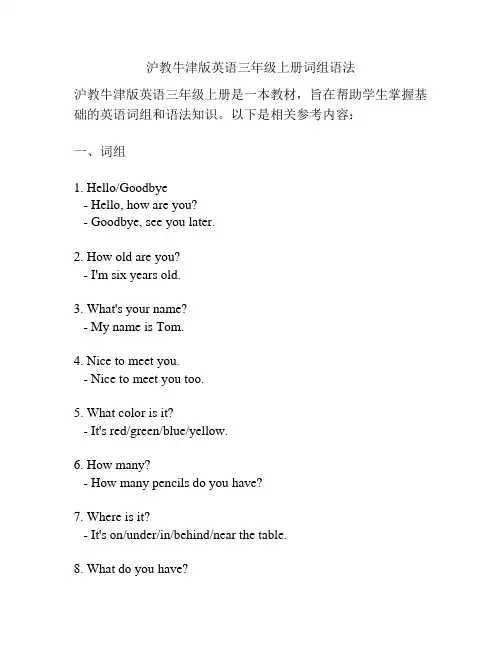
沪教牛津版英语三年级上册词组语法沪教牛津版英语三年级上册是一本教材,旨在帮助学生掌握基础的英语词组和语法知识。
以下是相关参考内容:一、词组1. Hello/Goodbye- Hello, how are you?- Goodbye, see you later.2. How old are you?- I'm six years old.3. What's your name?- My name is Tom.4. Nice to meet you.- Nice to meet you too.5. What color is it?- It's red/green/blue/yellow.6. How many?- How many pencils do you have?7. Where is it?- It's on/under/in/behind/near the table.8. What do you have?- I have a book/pencil/bag.9. How do you go to school?- I go to school by bus/by bike/on foot.10. What's the weather like?- It's sunny/cloudy/windy/rainy.二、语法1. Be动词的用法- I am happy.- You are my friend.- He is a teacher.- She is a doctor.- It is a cat.- We are in the park.- They are students.2. 人称代词的用法- I am a student.- You are my friend.- He is a teacher.- She is a doctor.- We are in the park.- They are students.3. 冠词的用法- This is a pencil.- That is an apple.- I have an eraser.- She has a doll.- We are playing with a ball.4. 名词的复数形式- I have two pencils.- They are my friends.- We have three books.5. 人称代词的所有格- This is my pen.- That is your book.- It is his/her bag.- These are our toys.- Those are their bikes.6. 一般现在时的用法- I like to play soccer.- He likes to read books.- She likes to sing songs.- We like to eat ice cream.- They like to watch movies.7. 一般疑问句的构成- Do you like to dance?- Does he like to swim?- Does she like to play tennis? - Do we like to cook?- Do they like to paint?8. 物主代词的用法- This is mine.- That is yours.- It is his/hers.- These are ours.- Those are theirs.9. 数词的用法- I have one apple.- She has two cats.- They have three dogs.10. 时间状语的用法- I get up at 7 o'clock.- She goes to bed at 9 o'clock.- We have English class on Monday.- They go to the park in the morning.以上是沪教牛津版英语三年级上册的词组和语法相关参考内容。
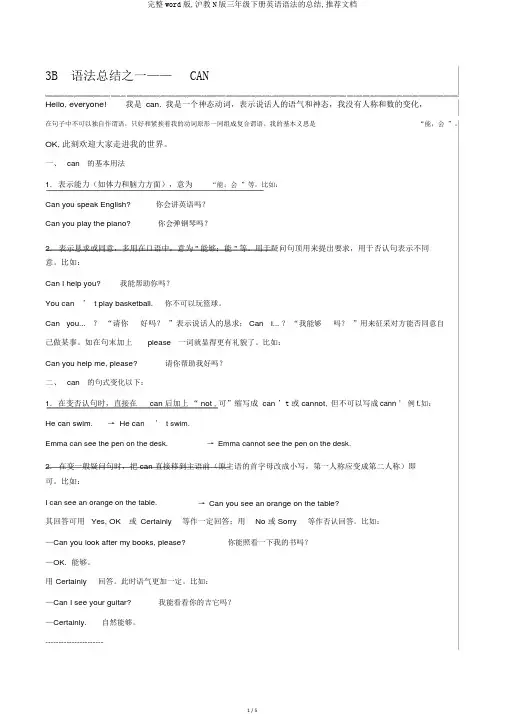
3B 语法总结之一——CANHello, everyone!我是can.我是一个神态动词,表示说话人的语气和神态,我没有人称和数的变化,在句子中不可以独自作谓语,只好和紧挨着我的动词原形一同组成复合谓语。
我的基本义思是“能;会”。
OK, 此刻欢迎大家走进我的世界。
一、can的基本用法1.表示能力(如体力和脑力方面),意为“能;会”等。
比如:Can you speak English?你会讲英语吗?Can you play the piano?你会弹钢琴吗?2.表示恳求或同意,多用在口语中,意为 " 能够;能 " 等。
用于疑问句顶用来提出要求,用于否认句表示不同意。
比如:Can I help you?我能帮助你吗?You can’ t play basketball.你不可以玩篮球。
Can you...?“请你好吗?”表示说话人的恳求;Can I... ?“我能够吗?”用来征采对方能否同意自己做某事。
如在句末加上please一词就显得更有礼貌了。
比如:Can you help me, please?请你帮助我好吗?二、can的句式变化以下:1.在变否认句时,直接在can 后加上“ not , 可”缩写成 can ’t或 cannot,但不可以写成cann ’例t.如:He can swim.→ He can’ t swim.Emma can see the pen on the desk. →Emma cannot see the pen on the desk.2.在变一般疑问句时,把 can 直接移到主语前(原主语的首字母改成小写,第一人称应变成第二人称)即可。
比如:I can see an orange on the table. →Can you see an orange on the table?其回答可用Yes, OK或Certainly等作一定回答;用No 或 Sorry等作否认回答。
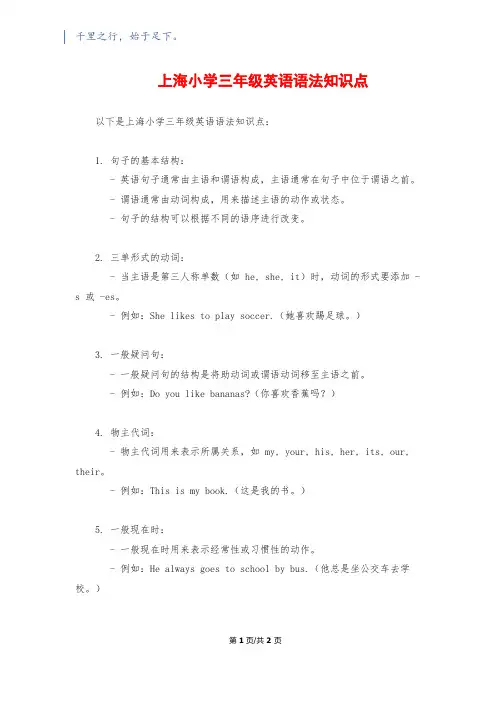
千里之行,始于足下。
上海小学三年级英语语法知识点以下是上海小学三年级英语语法知识点:1. 句子的基本结构:- 英语句子通常由主语和谓语构成,主语通常在句子中位于谓语之前。
- 谓语通常由动词构成,用来描述主语的动作或状态。
- 句子的结构可以根据不同的语序进行改变。
2. 三单形式的动词:- 当主语是第三人称单数(如 he, she, it)时,动词的形式要添加 -s 或 -es。
- 例如:She likes to play soccer.(她喜欢踢足球。
)3. 一般疑问句:- 一般疑问句的结构是将助动词或谓语动词移至主语之前。
- 例如:Do you like bananas?(你喜欢香蕉吗?)4. 物主代词:- 物主代词用来表示所属关系,如 my, your, his, her, its, our, their。
- 例如:This is my book.(这是我的书。
)5. 一般现在时:- 一般现在时用来表示经常性或习惯性的动作。
- 例如:He always goes to school by bus.(他总是坐公交车去学校。
)第1页/共2页锲而不舍,金石可镂。
6. 一般过去时:- 一般过去时用来表示过去发生的动作或状态。
- 例如:Yesterday, I played soccer with my friends.(昨天,我和我的朋友们踢足球。
)7. 现在进行时:- 现在进行时用来表示当前正在进行的动作。
- 例如:She is reading a book now.(她现在正在看书。
)8. 比较级:- 比较级用来表示两个事物之间的比较。
- 例如:The elephant is bigger than the mouse.(大象比老鼠大。
)9. 形容词的用法:- 形容词用来描述人、物的特征或状态。
- 例如:She is a beautiful girl.(她是一个漂亮的女孩。
)10. 不定代词:- 不定代词用来指代不确定的人或物。
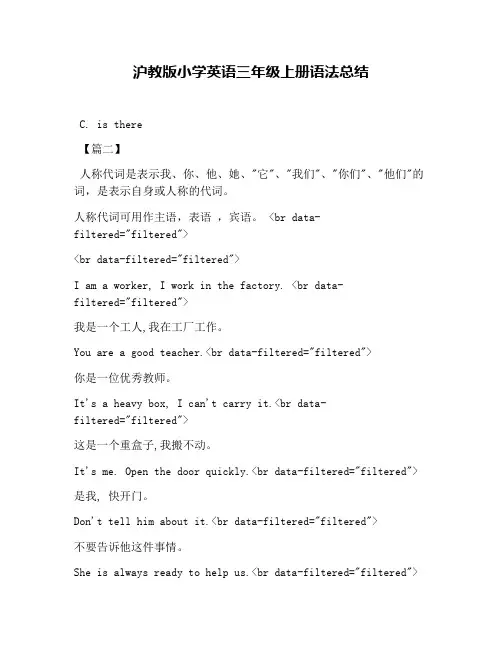
沪教版小学英语三年级上册语法总结C. is there【篇二】人称代词是表示我、你、他、她、"它"、"我们"、"你们"、"他们"的词,是表示自身或人称的代词。
人称代词可用作主语,表语,宾语。
<br data-filtered="filtered"><br data-filtered="filtered">I am a worker, I work in the factory. <br data-filtered="filtered">我是一个工人,我在工厂工作。
You are a good teacher.<br data-filtered="filtered">你是一位优秀教师。
It's a heavy box, I can't carry it.<br data-filtered="filtered">这是一个重盒子,我搬不动。
It's me. Open the door quickly.<br data-filtered="filtered">是我, 快开门。
Don't tell him about it.<br data-filtered="filtered">不要告诉他这件事情。
She is always ready to help us.<br data-filtered="filtered">她随时都在准备协助我们。
Our teacher is very strict with us.<br data-filtered="filtered">我们的老师对我们很严格。
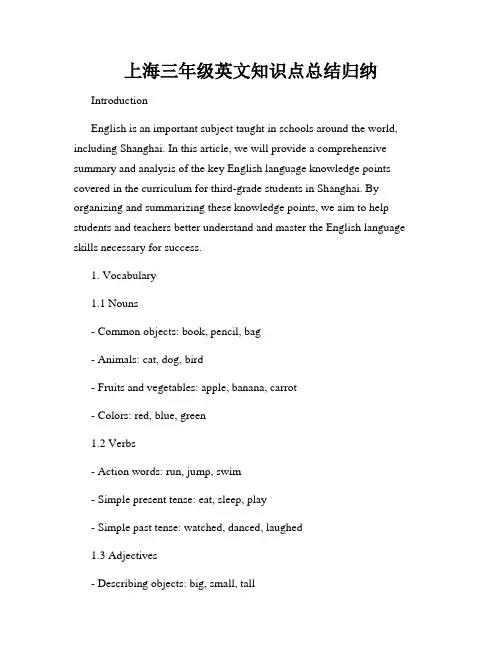
上海三年级英文知识点总结归纳IntroductionEnglish is an important subject taught in schools around the world, including Shanghai. In this article, we will provide a comprehensive summary and analysis of the key English language knowledge points covered in the curriculum for third-grade students in Shanghai. By organizing and summarizing these knowledge points, we aim to help students and teachers better understand and master the English language skills necessary for success.1. Vocabulary1.1 Nouns- Common objects: book, pencil, bag- Animals: cat, dog, bird- Fruits and vegetables: apple, banana, carrot- Colors: red, blue, green1.2 Verbs- Action words: run, jump, swim- Simple present tense: eat, sleep, play- Simple past tense: watched, danced, laughed1.3 Adjectives- Describing objects: big, small, tall- Describing feelings: happy, sad, excited2. Grammar2.1 Sentence Structure- Subject + verb: He eats.- Subject + verb + object: She reads a book.- Subject + verb + adverb: They play together happily.2.2 Verb Tenses- Simple present tense: I read books every day.- Simple past tense: We watched a movie yesterday.- Future tense: She will go to the park tomorrow.2.3 Question Formation- Yes/No questions: Do you like ice cream?- Wh- questions: What is your favorite color?3. Reading Comprehension3.1 Phonics and Decoding- Pronunciation of letters and sounds: A, B, C- Blending sounds to form words: cat, dog, sun3.2 Reading Strategies- Understanding story elements: characters, setting, plot- Identifying main ideas and details in a text3.3 Vocabulary in Context- Using context clues to understand the meaning of unfamiliar words- Making predictions based on information provided in the text4. Writing4.1 Sentence Formation- Capitalization and punctuation: The cat is black. (correct) the cat is black. (incorrect)- Expanding simple sentences using conjunctions: I like to swim, and I like to jump.4.2 Paragraph Organization- Introduction, body, and conclusion in writing- Use of transition words to connect ideas: first, next, finally4.3 Descriptive Writing- Describing objects, animals, and people- Using adjectives and sensory language to enhance descriptions5. Listening and Speaking5.1 Listening Comprehension- Following oral instructions- Identifying specific information in a spoken passage5.2 Expressing Ideas and Opinions- Participating in class discussions- Giving presentations on familiar topicsConclusionThe third-grade English curriculum in Shanghai covers various key knowledge points essential for language learning. By understanding and practicing these vocabulary, grammar, reading comprehension, writing, listening, and speaking skills, students can improve their overall English proficiency. Teachers can utilize this summary as a guide to ensure comprehensive instruction and effective assessment. With dedication and consistent practice, students will continue to develop their English language abilities and succeed in their language learning journey.。
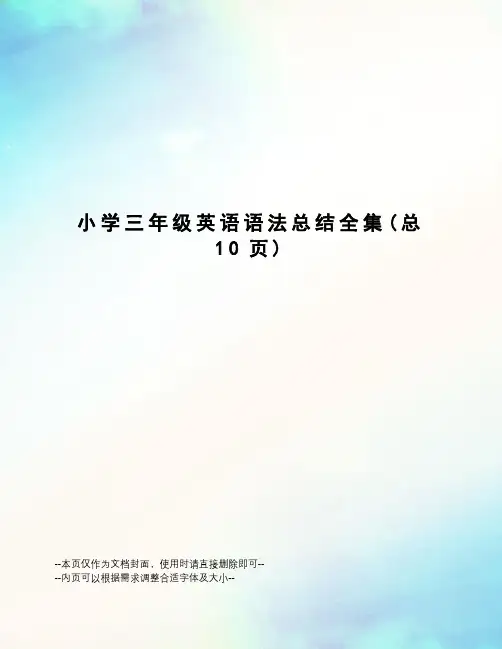
小学三年级英语语法总结全集(总10页)--本页仅作为文档封面,使用时请直接删除即可----内页可以根据需求调整合适字体及大小--小学三年级英语语法总结全集一、名词复数规则1、一般情况下,直接加-s,如: book-books, bag-bags, cat-cats, bed-beds2、以s. x. sh. ch结尾,加-es,如: bus-buses, box-boxes, brush-brushes, watch-watches3、以“辅音字母+y”结尾,变y为i, 再加-es,如: family-families, strawberry-strawberries4、以“f或fe”结尾,变f或fe为v, 再加-es,(但有一个特例:roof→roofs)。
如: knife-knives leaf-leaves wife-wives thief-thieves wolf-wolves5、以“o”结尾的单词,如果有生命,加-es;如果没有生命,加-s。
如:(1)有生命:potato-potatoes tomato-tomatoes mango-mangoeshero-heroes Negro- Negroes(2)没生命:radio-radios piano-pianos photo-photos zoo-zoos6、完全不规则(1) woman-women policeman-policemen policewoman-policewomen(2)mouse-mice child-children foot-feet tooth-teeth man-men7、单数复数词形相同fish-fish sheep-sheep deer-deer people-people Chinese-Chinese Japanese-Japanese二、一般现在时1、一般现在时的功能(1)、表示事物或人物的特征、状态。
沪教版英语三年级知识点总结【最新版】目录一、沪教版英语三年级下册知识点总结概述二、核心词汇1.颜色词2.食物词3.味觉形容词4.交通工具名词5.动词三、三年级下册全册知识总结1.Module 1 使用我的五感2.Module 2 食物3.Module 3 交通工具4.Module 4 动词四、沪教版英语三年级下册音频资源五、四年级和六年级知识点汇总概述正文一、沪教版英语三年级下册知识点总结概述沪教版英语三年级下册全册知识总结涵盖了颜色、食物、味觉形容词、交通工具和动词等知识点。
通过这些知识点的学习,学生可以巩固和拓展英语基础词汇和语法,为进一步学习英语打下坚实基础。
二、核心词汇1.颜色词:如 black(黑色)、blue(蓝色)、green(绿色)、red(红色)、white(白色)和 yellow(黄色)等。
2.食物词:如 candy(糖果)、lemon(柠檬)、ice-cream(冰淇淋)和 banana(香蕉)等。
3.味觉形容词:如 sour(酸的)、sweet(甜的)等。
4.交通工具名词:如 bike(自行车)、bus(公共汽车)、plane(飞机)、ship(船)和 car(小汽车)等。
5.动词:如 hear(听见)、listen(倾听)、smell(闻)和 touch (触摸)等。
三、三年级下册全册知识总结1.Module 1 使用我的五感本模块主要学习如何运用五感(视觉、听觉、嗅觉、味觉和触觉)描述日常生活中的事物。
通过学习这个模块,学生可以提高自己的观察力和表达能力。
2.Module 2 食物本模块主要学习各种食物的英语表达方式。
学生可以通过学习这个模块,拓宽自己的词汇量,了解不同文化的食物表达方式。
3.Module 3 交通工具本模块主要学习各种交通工具的英语表达方式。
学生可以通过学习这个模块,了解全球各地的交通工具,为将来的旅行和生活做好准备。
4.Module 4 动词本模块主要学习一些常见的动词,如 hear、listen、smell 和touch 等。
沪教版小学英语三年级下册笔记一、be动词,am is arebe动词:am, is, are(翻译成:是)Be动词口诀:I用am,You用are, Is连着她他它,单数is复数are.二、一般疑问句(最显著特点:可以用Yes或者No来回答)改成一般疑问句——be或者can提前(一)含be动词的句子改成一般疑问句(1)I am fat.(改成一般疑问句——be或者can提前)思考:①人称,问题和回答的是两个人,I和You是要互换的,跟You 搭配的是are(我和你)。
②调序:动词调到最前面去,动词是are。
③大小写要写正确,标点问句写问号。
Are you fat?(2)He is a good boy.Is he a good boy?(3)My name is Danny.______ ______ ______ ______(4)Alice is in the classroom.______ ______ ______ ______ ______?(5)They are red.______ ______ ______?(二)含can的句子改成一般疑问句(1)I can run.(改成一般疑问句——can提前)Can you run?(2)He can ride a bicycle. (改成一般疑问句,并肯定回答)______ ______ride a bicycle? ______ ______ ______(3)She can fly a kite. (改成一般疑问句,并否定回答)______ ______ fly a kite?______ ______ ______(4)It’s my dog. It can play with the ball.______ ______ play with the ball?一般疑问句的回答:Be动词单数Are you, are you? Yes, I am. No, I’m not.Is he, is he? Yes, he is. No, he isn’t.Is she, is she? Yes, she is. No, she isn’t.Is it, is it? Yes, it is. No, it isn’t.Be动词复数:Are you, are you? Yes, I am. No, I’m not.Are they, are they? Yes, they are. No, they aren’t.can单数:Can you, can you, Yes, I can. No, I can’t.Can he, can he, Yes, he can. No, he can’t.Can she, can she, Yes, she can. No, she can’t.can复数:Can you, can you, Yes, I can. No, I can’t.Can they, can they, Yes, they can. No, they can’t.1(三)用助动词do/does帮助,改写一般疑问句助动词的使用方法:实义动词的句子,变问句(一般和特殊都在内),没有可以提前的词;变否定句,没有可以加not的词。
上海三年级(上)英语牛津语法复习一、反义词复习和答案1.up---downe---go3.morning---night4.old---young5.tall----short 上下来去白天黑夜年老年轻高矮6.fat---thin7.open---close8.black---white9.long---short 10.new---old 胖瘦开关黑白长短新旧11.big---small 12.Yes---no 13.hot---cold 14.warm----cool 15.stand---sit 大小是不是热冷暖和凉爽站坐16.go---stop 17.soft ---- hard 18.smooth ---- rough走停软硬光滑粗糙二、单词复习和答案1.Mrs 先生2.Miss小姐3.stand up 起立4.sit down 坐下5.open the door 开门6.close the door 关门7.open the window 开窗8.close the window 关窗三、肯定回答、否定回答复习和答案1. Are you a pupil?2. Are you doctors?3. Is she in the classroom?4. Is your father a policeman?5. Are they in Class One?6.Can you dance?7. Are Tom and you playing games ? 8. Have you got a toy car?1.Yes,I am. No,I am not.2.Yes,I am. No,I am not.3.Yes,she is. No,she isn't.4.Yes,he is. No,he is.5.Yes,they are. No,they aren't.6.Yes,I can. No,I can't .7.Yes,we are. No,we aren't.8.Yes,I have. No,I haven't.9. Has your mother got a red coat?10. Has the boy got any grapes?9.Yes,she has. No,she hasn't.10.Yes,he has. No,he hasn't.分四步第一步,一定要有Yes 和No第二步,你换成我,比如Are you Peter?Yes, I am.你是皮特吗?是的,我是注意:只有‘你’换成‘我’,其他直接第三步第三步,回答倒过来。
上海小学英语语法归纳总结英语语法是学习英语过程中非常重要的一部分,尤其对于小学生来说,掌握好基本的语法规则是打好英语基础的关键。
本文将为大家总结上海小学英语语法的常见规则和注意事项。
一、名词名词是指表示人、事物、地方等概念的词。
根据名词的不同形式和用法,可以分为以下几类:1. 单数名词:表示一个人或物的名词,例如:book(书)、apple(苹果)等。
例句:I have a book.2. 复数名词:表示多个人或物的名词,在名词后面通常加上-s或-es,例如:books(书)、apples(苹果)等。
例句:We have many books.3. 不可数名词:表示无法具体数清的名词,通常不加-s或-es,例如:water(水)、milk(牛奶)等。
例句:I like drinking water.4. 特殊名词:表示特定事物或人的名词,需要特别注意其复数形式的变化,例如:child(孩子)→children(孩子们)、man(男人)→men(男人们)等。
例句:There are many children in the park.二、代词代词用来代替名词,能够减少重复使用。
常见的代词包括:1. 主格代词:用于代替主语的代词,例如:I(我)、he(他)等。
例句:I am a student.2. 宾格代词:用于代替宾语的代词,例如:me(我)、him(他)等。
例句:The teacher is talking to me.3. 形容词性物主代词:表示所属关系的代词,例如:my(我的)、his(他的)等。
例句:This is my book.4. 名词性物主代词:用来代替名词的代词,例如:mine(我的)、hers(她的)等。
例句:This book is mine.三、动词动词是表示动作或状态的词,根据时态和语态的不同,可以分为以下几类:1. 一般现在时:表示经常发生的动作或状态,动词原形加-s或-es。
2018 沪教三年级英语下册语法知识点汇总1. look 是不及物动词,要与介词 at 连用,才干后接宾语。
Look at 意为“看某物”。
2. Listen 意为“听”,是不及物动词,需与介词 to 连用才干后接宾语。
3. 形容词性物主代词+名词,表示某人的某物。
例:her name his book拓宽:名词性物主代词例:This book is hers.4. have 和 has都表明“有”。
当主语是榜首人称、第二人称或第三人称复数时,要用 have;当主语是第三人称奇数时,要用 has.5. this 表明“这个”,this is 不能缩写。
复数方式是 these“这些”;that 表明“那个”,that is 能够缩写,为______。
复数方式是 _______“那些”。
6.易错的复数方式: bus—— leaf—— tooth —— it——7.Do/Does+主语+like sth.? 用来询问某人是否做某事。
肯定回答用:Yes,主语+do/does.否定回答用:No,主语+don’t/doesn ’t.8. like+可数名词/不可数名词,表示喜欢某类事物。
like+doing sth./to do sth. 表示喜欢做某事。
9. what colour 用来问询色彩; what ______ 用来问询时节; what______用来询问时刻; what_______用来问询形状。
10. Can+主语+do sth.? 用来询问某人是否会做某事。
肯定回答用:Yes,主语+can.否定回答用:No,主语+can’t11. be动词运用口诀:我用 am,你用 are,is连着他 /她/ 它。
奇数全用 is,复数全用are.12. How do/does+物品+feel/taste/smell? 用来询问对物品的感觉。
例: This banana is soft.(对划线部分进行发问)13.当指代之前出现货的东西时,要用定冠词the.例:I like these flowers,but I don’t like the green one.14. want to do sth. 想要做某事15.含有实义动词的陈述句改一般疑问句的办法:一加二变三问号一加:在句首加动词do/does二变:动词变原形三问号:句号变问号He has a pen.(改一般疑问句)___________________________________________________16. What are these/those/they? 回答都使用:They’re⋯⋯17. play+运动项目play+the+乐器18. in+某种语言,表示“用⋯⋯说”。
1.沪教三年级英语下册语法知识点汇总2.look是不及物动词;要与介词at连用;才能后接宾语。
Look at意为“看某物”。
3.Listen意为“听”;是不及物动词;需与介词to连用才能后接宾语。
4.形容词性物主代词+名词;表示某人的某物。
例:her name his book拓展:名词性物主代词例:This book is hers.5.have和has都表示“有”。
当主语是第一人称、第二人称或第三人称复数时;要用have;当主语是第三人称单数时;要用has.6.this 表示“这个”;this is 不能缩写。
复数形式是these“这些”;that 表示“那个”;that is 可以缩写;为______。
复数形式是_______“那些”。
6.易错的复数形式:bus——leaf——tooth——it——7.Do/Does+主语+like sth.? 用来询问某人是否做某事。
肯定回答用:Yes,主语+do/does.否定回答用:No,主语+don’t/doesn’t.8.like+可数名词/不可数名词;表示喜欢某类事物。
like+doing sth./to do sth. 表示喜欢做某事。
9.what colour 用来询问颜色;what ______用来询问季节;what______用来询问时间;what_______用来询问形状。
10.Can+主语+do sth.? 用来询问某人是否会做某事。
肯定回答用:Yes,主语+can.否定回答用:No,主语+can’t11.be动词运用口诀:我用am;你用are,is 连着他/她/它。
单数全用is,复数全用are.12.How do/does+物品+feel/taste/smell? 用来询问对物品的感觉。
例:This banana is soft.(对划线部分进行提问)13.当指代之前出现货的东西时;要用定冠词the.例:I like these flowers,but I don’t like the green one.14.want to do sth. 想要做某事15.含有实义动词的陈述句改一般疑问句的方法:一加二变三问号一加:在句首加动词do/does二变:动词变原形三问号:句号变问号He has a pen.(改一般疑问句)___________________________________________________16.What are these/those/they?回答都使用:They’re……17.play+运动项目play+the+乐器18.in+某种语言;表示“用……说”。
上海徐汇区小学三年级英语语法全第1讲字母1、英语中共有26个字母。
Aa,Ee,Ii,Oo,Uu是元音字母,Yy是半元音字母,其余是辅音字母。
英语单词就是由这26个字母组合而成的。
Aa和Ii可以独立成词,分别表示“一个(张……)”和“我”的意思,Ii翻译成“我”时要大写。
2、英语字母可以分为印刷体和书写体。
在书、报、杂志上见到的一般都是印刷体。
在四线三格上书写时应注意书写位置,可以记住以下口诀:大写字母不顶格,小写字母占满格。
书写时还要注意字母的笔顺。
3、英语句子的第一个单词的首字母要大写。
单词与单词之间在书写时必须保持适当的距离,一般以空出一个小写字母的宽度为宜。
句子的末尾要有标点符号。
4、英语中的句号是一个实心圆点(.),省略号是三个居下的实心圆点(…),英语中没有顿号和书名号,顿号用逗号替代,书名用斜体字表示。
5、英语缩写词PRC中华人民共和国UN 联合国WHO 世界卫生组织NBA美国职业篮球联赛KFC 肯德基IT 信息技术EQ 情商CCTV 中国中央电视台kg 千克a.m. 上午USA 美国HK 香港WTO 世界贸易组织CBA 中国男子篮球联赛ATM 自动柜员机ID 身份证CPU 中央处理器BBC 英国广播公司cm 厘米p.m. 下午UK 英国SOS 国际求救信号UFO 不明飞行物VIP 贵宾EMS邮政特快专递IQ 智商RMB 人民币VOA 美国之音No. 号码6/ eɪ / Aa Hh Jj Kk/ i: / Ee Bb Cc Dd Gg Pp Tt Vv (Zz)/ aɪ / Ii Yy/ǝʊ / Oo/ju:/ Uu Qq Ww/ e / Ff Ll Mm Nn Ss Xx Zz/ɑ: / Rr第2讲语音1、音素:语音的最小单位。
元音单元音/i:/,/ɪ/,/ɜ:/,/ə/,/ɑ:/,/Λ/,/ɔ:/,/ɒ/,/u:/,/ʊ/,/e/,/æ/ 双元音/eɪ /,/aɪ/,/ɔɪ/,/əʊ/,/aʊ/,/ɪǝ/,/eə/,/ʊə/辅音清辅音/p/,/t/,/k/,/t⎰/,/tr/,/ts/,/f/,/θ/,/s/,/∫/,/h/浊辅音/b/,/d/,/g/,/dʒ/,/dr/,/dz/,/V/,/ð/,/z/,/ʒ/,/r/,/m/,/n/,/ŋ/,/l/,/w/,/j/2、元音:发音时气流不受阻碍。
元音分为单元音和双元音两类。
单元音发音时唇形和舌位不变;双元音发音时由一个元音向另一个元音滑动,唇形和舌位有一个变化过程,且前重后轻,前长后短。
3、辅音:发音时气流受到阻碍。
辅音分为清辅音和浊辅音两类。
清辅音发音时声带不振动;浊辅音发音时声带振动。
4、音标:用来记录音素的符号。
为了避免与字母混淆,音标被放在斜括号/ /内。
5、英语中的一个字母或字母组合在不同的单词中发音可能是不一样的,而相同的发音对应的字母或字母组合也可能不完全相同。
6、开音节:以元音字母结尾或以一个元音字母加一个辅音字母再加不发音的e结尾(r除外)的音节。
元音字母在开音节中读长音,即该字母的名称音。
闭音节:以一个或几个辅音字母(r除外)结尾。
元音字母在闭音节中读短音。
a e i o u开音节/eɪ /name/i:/we she/aɪ/hi white/əʊ/go note/ju:/ or /u:/use闭音节/æ/map/e/desk/ɪ/sit/ɒ/clock/ /cup第3讲名词名词是指表示人和事物名称的词,可以分为专有名词和普通名词两大类。
1、专有名词:特定的人、地方、机构等专有的名称。
第一个字母通常要大写。
e.g. Jim Green,New York,Bank of China,Peking University星期、月份、节日、学科、报刊名也是专有名词。
e.g. Monday,May,Christmas,Spring Festival,Maths,China Daily2、普通名词:表示一类人或物或抽象概念的名称。
普通名词又可以分为四类:个体名词——表示某类人或东西中的个体,如:student , desk集体名词——表示若干个体组成的集合体,如:class , family物质名词——表示无法分为个体的物质名称,如:water , rice , sand,hair抽象名词——表示情感,状态,品质等抽象名称,如:love ,carelessness个体名词和集体名词多数可以用数目来计算,称为可数名词,有单、复数形式;物质名词和抽象名词通常无法用数目计算,称为不可数名词,一般只有一种形式。
注意:①集体名词被看作一个整体时,表达单数概念。
e.g. His family was well known in the town.他家在镇里是名门望族。
②集体名词被看作若干个体的集合时,表达复数概念。
e.g. His family are waiting for him.她的家人正在等他。
③集体名词表达多个集体时,也有复数形式。
e.g. Our village is made up of 300 families. 我们村有300户人家。
3、可数名词复数形式的构成规则:①一般名词在末尾直接加s,清辅音后读/ s /,浊辅音和元音后读/ z /e.g. book-books,bag-bags,cat-cats,bed-beds②以s、x、sh、ch结尾,加es,读/ IZ /e.g. bus-buses,box-boxes,brush-brushes,watch-watches③以辅音字母+y结尾,变y为i,再加es,读/ z /e.g. baby-babies,library-libraries,factory-factories④以f或fe结尾,变f或fe为v,再加es,读/ vz /e.g. thief-thieves,knife-knives⑤以o结尾,表示无生命的物体时加s, 表示有生命的物体时,加es,都读/ z /e.g. photo-photos,piano-pianos,radio-radios,zoo-zoospotato-potatoes,tomato-tomatoes,mango-mangoes,hero-heroes⑥不规则变化e.g. man-men child-children foot-feetfish-fish woman-women mouse-mice tooth-teethsheep-sheeppoliceman-policemenox-oxengoose-geesedeer-deer▲fish表示鱼的数量时,单复数同形;表示鱼的种类时,复数为fishes.e.g. My cat had two fish for lunch.You can see a lot of different fishes in the lake.4、不可数名词一般只有原形,没有复数形式,但是可以借助量词表示一定的数量。
如果表达两个或两个以上的概念时,量词需要用复数形式,不可数名词不变。
e.g. a bottle of water ,a cup of coffee,two glasses of milk ,five bags of rice▲这种形式用于可数名词时,量词和可数名词都要用复数。
e.g. ten baskets of eggs5、既可用作可数,又可用作不可数的名词:不可数glass 玻璃paper 纸iron 铁wood 木头beauty 美room 空间可数a glass 一只玻璃杯a paper 一份报纸、论文、文件a iron 一个熨斗a wood 一片森林a beauty 一个美人a room 一个房间6、名词所有格①在英语中,有些名词可以加’s来表示所有关系,带这种词尾的名词形式称为该名词的所有格。
大多数表示有生命的东西。
e.g. Tom’s book②如果复数名词末尾已有s,就直接加’。
e.g. the teachers’ office③如果一些物品为两者共有,只需在后一个名词后加’s ;如果为各自所有,则需在每个名词后加’s。
e.g. Lucy and Lily’s bedroom.(Lucy 和Lily共用一个卧室)Lucy’s and Lily’s bedrooms.(Lucy 和Lily分别拥有各自的卧室)④表示无生命的物体的名词所有格,一般与of短语连用。
e.g. a map of the world ,a photo of my family⑤双重所有格:把of所有格和’s所有格结合在一起表示所有关系。
e.g. a friend of my father’s第4讲冠词冠词一般用在名词的前面,对名词起限定作用,不能离开名词单独存在。
1、不定冠词a,an用在单数可数名词前面,泛指一类人或物中的任何一个。
①a用于辅音音素开头的名词之前。
e.g. a bed,a computer,a “U”②an用于元音音素开头的名词之前。
e.g. an egg,an umbrella,an hour2、定冠词the用在单数或复数可数名词前,也可用在不可数名词前。
①表示特指的人或物前。
e.g. The man with a flower in his hand is Jack.②指说话人双方都知道的人或物前。
e.g. Lily, close the door, please.③在上文提到过,第二次又提到的人或物前。
e.g. There is a man under the tree. The man is called James.④表示世界上独一无二的事物前。
e.g. The sun is bigger than the moon.⑤用在序数词前面。
e.g. It is the first day of the new term.⑥用在乐器名称前。
e.g. He often plays the violin at weekends.⑦用在形容词最高级前。
e.g. Spring is the best season in a year.⑧用在由普通名词构成的专有名词前。
e.g. I went to the Great Wall last week.⑨用在国家名称的缩写前。
e.g. He is from the UK.3、零冠词:名词前不用冠词的情况。
在季节、月份、星期、节假日、三餐、球类或棋类运动前,通常不用冠词。
e.g. have breakfast ,play basketball,play chess第5讲代词我你他她它我们你们他们主格I you he she it we you they 宾格me you him her it us you theme.g. I am a student. They are cleaning the classroom.②宾格可以用来表示动作行为的对象,一般用在动词和介词后面。